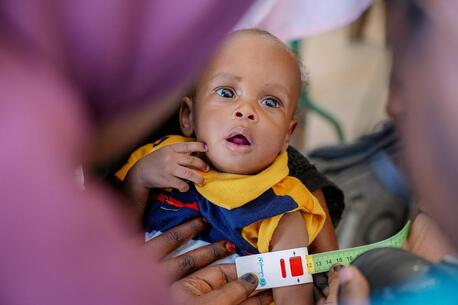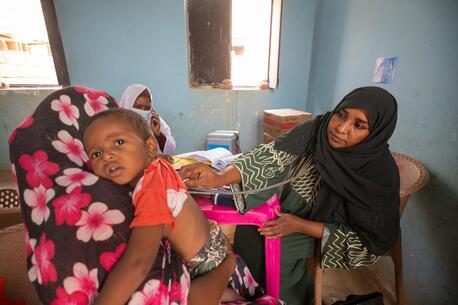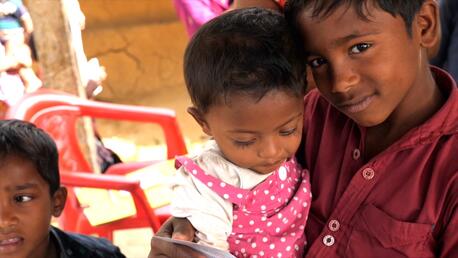
As Malnutrition Rates Soar in Burkina Faso, UNICEF Steps Up Assistance
Food insecurity is on the rise in Burkina Faso. UNICEF is increasing efforts to reach vulnerable children in need.
KAYA, BURKINA FASO – “When I save the life of a child, my heart is filled with joy,” says Aminata Zabré, who oversees nutrition at the UNICEF-supported Sector 6 Health and Social Center in the district of Kaya, north central Burkina Faso. "Every time I see a child dying, I say to myself: He shouldn't be there. His life could have been saved."
For the past ten years, Zabré has screened and treated thousands of malnourished children in Burkina Faso, and she has saved countless children’s lives. Her love for children makes her a hero in her community.
“I love children and I dedicate a lot of my time and energy to do my work and to make sure no child that comes to me is left unattended, even if it means I have less time for my own family,” says Zabré.

Aminata Zabré oversees nutrition services at the UNICEF-supported Health and Social Center in Sector 6 in Kaya, Burkina Faso. © UNICEF/UN0662356/Cisse
Due to rising levels of insecurity over the past few years, nearly 2 million people are internally displaced in Burkina Faso. Zabré has seen the number of acutely malnourished children coming to her rise sharply as well. Ten years ago, the center treated approximately 100 malnourished children per year. By 2020, the annual total had risen to 250. This year, that number has exploded. In the first quarter of 2022 alone, Zabré has treated more than 600 children suffering from acute malnutrition.
Zabré and her team use Ready-to-Use Therapeutic Food (RUTF) to bring malnourished children back to health. RUTF, a nutritious peanut paste, comes in single-serving sachets that cost about 35 cents each. Malnourished children need a regular diet of two sachets per day to gain enough weight to overcome malnutrition. UNICEF is by far the largest provider of RUTF for the treatment of acutely malnourished children in Burkina Faso.
UNICEF is the largest supplier of the Ready-to-Use Therapeutic Food used to treat acutely malnourished children in Burkina Faso

Amadou Tall, UNICEF Burkina Faso Supply and Logistics Manager, stands next to boxes of Ready-to-Use Therapeutic Food (RUTF) awaiting transportation in the UNICEF warehouse in Ouagadougou, Burkina Faso on June 24, 2022. © UNICEF/UN0662363/Cisse
Amadou Tall is the Supply and Logistics Manager for UNICEF in Burkina Faso. He explains that the price of RUTF has increased by 16 percent in the past three months due to soaring costs of the raw products used to make RUTF and to fortify it. Extra charges for transport and logistics are also responsible for the increase in price. With RUTF supplies dwindling, UNICEF will need additional resources to meet the growing demand and increasing prices.
RUTF can restore an acutely malnourished child to health in a matter of months

On June 21, 2022 at the Social Promotion Health Center in Kaya, Burkina Faso, Habibou, 23, carries her 6-month-old son, Abdul Razak, who is suffering from severe acute malnutrition, and a bag of RUTF sachets, the packets of nutritious peanut paste she received for his treatment. © UNICEF/UN0660068/Cisse
Habibou is a young mother of two in Burkina Faso. She was forced to leave her village due to insecurity and is internally displaced in Kaya. She left behind the plot of land where she used to grow food. After a community outreach session led by local health workers, she was sent with her youngest child, Abdul Razak, who is 6 months old, to see Zabré and her team at the health center.
“When Abdul Razak was born, I was sick and couldn’t feed my child,” explains Habibou. “When I got better, I was able to start breastfeeding him, but I didn’t have enough milk for him.”
Zabré weighed and measured Abdul Razak and measured the circumference of his upper arm. The diagnosis was unquestionable: the young boy was severely acutely malnourished. If nothing was done, his health condition could have quickly deteriorated and he would have been at risk of dying.
I'm relieved that I can now feed my child ... Now with the [Ready-to-Use Therapeutic Food] sachets, I can give it to him when he's hungry and he stops crying. — Habibou, mother of 6-month-old Abdul Razak
After Zabré completed the examination, she gave Abdul Razak's mother 15 sachets of RUTF to take home and feed her child for the next week. After that, Habibou was asked to return to the health center for a follow-up visit, and to pick up enough RUTF for the following week. Abdul Razak’s treatment could take three to four months until the boy gains enough weight to recover from malnutrition and stabilize his growth. Until then, he will see Zabré and her team weekly.
“I’m relieved that I can now feed my child,” says Habibou. “I was unable to cook food to feed him. Now with the sachets, I can give it to him when he’s hungry, and he stops crying. They also told me to wash my hands regularly to avoid getting sick. I hope that Abdul Razak will grow quickly and stay healthy.”

At a UNICEF-supported malnutrition screening session in the village of Ngolo in northern Burkina Faso, mothers learn how to measure their children and how to prepare nutrient-enriched porridge using micronutrient powder distributed to mothers of children 6 to 23 months old. © UNICEF/UN0640866/Dejongh
UNICEF and partners are aiming to reach hundreds of thousands of acutely malnourished children like Abdul Razak with treatment this year in Burkina Faso. Supply of RUTF has been uninterrupted in the past years, but with the growing number of children and rising prices of therapeutic food, UNICEF needs additional resources to make sure no malnourished child is left behind. Every child who is severely malnourished must receive therapeutic treatment to survive and recover. It’s a matter of life or death for these children.
Your contribution will help UNICEF deliver lifesaving services and supplies to vulnerable children in Burkina Faso. Please donate.
Louis Vigneault-Duboi is UNICEF Chief of Communication, ESARO O/P Johannesburg, South Africa
Top photo: Konata Karko, a 24-year-old mother of two, feeds her acutely malnourished 1-year-old daughter, Mariam, with Ready-to-Use Therapeutic Food at the UNICEF-supported Health Center in Bobo-Dioulasso, southwestern Burkina Faso, on May 12, 2022. © UNICEF/UN0640824/Dejongh
HOW TO HELP
There are many ways to make a difference
War, famine, poverty, natural disasters — threats to the world's children keep coming. But UNICEF won't stop working to keep children healthy and safe.
UNICEF works in over 190 countries and territories — more places than any other children's organization. UNICEF has the world's largest humanitarian warehouse and, when disaster strikes, can get supplies almost anywhere within 72 hours. Constantly innovating, always advocating for a better world for children, UNICEF works to ensure that every child can grow up healthy, educated, protected and respected.
Would you like to help give all children the opportunity to reach their full potential? There are many ways to get involved.





